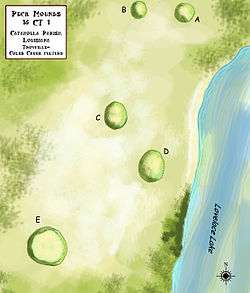Troyville culture
The Troyville culture is an archaeological culture in areas of Louisiana and Arkansas in the Lower Mississippi valley in the Southeastern Woodlands. It was a Baytown Period culture[1] and lasted from 400 to 700 CE during the Late Woodland period. It was contemporaneous with the Coastal Troyville and Baytown cultures (all three had evolved from the Marksville Hopewellian peoples) and was succeeded by the Coles Creek culture.[1] Where the Baytown peoples built dispersed settlements, the Troyville people instead continued building major earthwork centers.[2][3]

Subsistence
The Troyville-Coles Creek people lived on gathered wild plants and local domesticates, and maize was of only minor importance.[4] Acorns, persimmons, palmetto, maygrass, and squash were all more important than maize.[4] Tobacco was cultivated as well, and protein came from deer and smaller mammals, but the bounty of the region kept maize from being adopted as a staple until as late as the thirteenth century CE.[4]
Known Troyville culture sites
| Site | Image | Description |
|---|---|---|
| DePrato Mounds | A multimound complex located in Concordia Parish, Louisiana, radiocarbon and decorated pottery dated to about 600 CE during the Troyville/Coles Creek period.[5] | |
| Greenhouse Site |  |
A multimound site in Avoyelles Parish, Louisiana from the Troyville-Coles Creek Period[6] |
| Marsden Mounds | A multimound site in Richland Parish, Louisiana near Delhi, Louisiana, with a Poverty Point period component (1500 BCE) and a Troyville-Coles Creek component (400 to 1200 CE).[7] | |
| Peck Mounds |  |
A multimound site from the Late Troyville-Early Coles Creek period located in Catahoula Parish, Louisiana[8] |
| Troyville Earthworks |  |
A large multimound site with components dating from 100 BCE to 700 CE. It once had the tallest mound in Louisiana at 82 feet (25 m) in height. It is located in Catahoula Parish, Louisiana in the town of Jonesville.[9] It is the type site for the culture. |
| Venable Mound | A single mound site with components from the Troyville, Coles Creek and Plaquemine periods, located in Morehouse Parish, Louisiana[10] | |
References
- Raymond Fogelson (September 20, 2004). Handbook of North American Indians : Southeast. Smithsonian Institution. ISBN 978-0-16-072300-1.
- "Southeastern Prehistory : Late Woodland Period". NPS.GOV. Retrieved 2011-10-23.
- Timothy P Denham; José Iriarte; Luc Vrydaghs, eds. (2008-12-10). Rethinking Agriculture: Archaeological and Ethnoarchaeological Perspectives. Left Coast Press. pp. 199–204. ISBN 978-1-59874-261-9.
- Snow, Dean R. (2010). Archaeology of Native North America. New York: Prentice-Hall. p. 244.
- "Indian Mounds of Northeast Louisiana : Deprato Mounds". Archived from the original on 2012-12-24. Retrieved 2011-10-21.
- "Louisiana Prehistory:Marksville, Troyville-Coles Creek, and Caddo". Archived from the original on 2012-01-10. Retrieved 2011-10-20.
- "Indian Mounds of Northeast Louisiana:Marsden Mounds". Archived from the original on 2013-05-14. Retrieved 2011-10-20.
- "Indian Mounds of Northeast Louisiana:Peck Mounds". Archived from the original on 2012-12-24. Retrieved 2011-10-20.
- "Indian Mounds of Northeast Louisiana: Transylvania Mounds". Archived from the original on 2014-03-20. Retrieved 2011-10-20.
- "Indian Mounds of Northeast Louisiana:Venable Mound". Archived from the original on 2012-12-24. Retrieved 2011-10-20.
External links
| Wikimedia Commons has media related to Troyville culture. |
